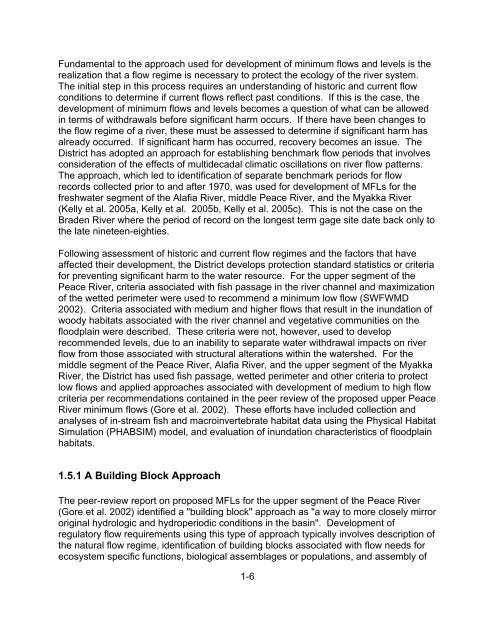Chapter 1 Minimum Flows and Levels - Southwest Florida Water ...
Chapter 1 Minimum Flows and Levels - Southwest Florida Water ...
Chapter 1 Minimum Flows and Levels - Southwest Florida Water ...
Create successful ePaper yourself
Turn your PDF publications into a flip-book with our unique Google optimized e-Paper software.
Fundamental to the approach used for development of minimum flows <strong>and</strong> levels is the<br />
realization that a flow regime is necessary to protect the ecology of the river system.<br />
The initial step in this process requires an underst<strong>and</strong>ing of historic <strong>and</strong> current flow<br />
conditions to determine if current flows reflect past conditions. If this is the case, the<br />
development of minimum flows <strong>and</strong> levels becomes a question of what can be allowed<br />
in terms of withdrawals before significant harm occurs. If there have been changes to<br />
the flow regime of a river, these must be assessed to determine if significant harm has<br />
already occurred. If significant harm has occurred, recovery becomes an issue. The<br />
District has adopted an approach for establishing benchmark flow periods that involves<br />
consideration of the effects of multidecadal climatic oscillations on river flow patterns.<br />
The approach, which led to identification of separate benchmark periods for flow<br />
records collected prior to <strong>and</strong> after 1970, was used for development of MFLs for the<br />
freshwater segment of the Alafia River, middle Peace River, <strong>and</strong> the Myakka River<br />
(Kelly et al. 2005a, Kelly et al. 2005b, Kelly et al. 2005c). This is not the case on the<br />
Braden River where the period of record on the longest term gage site date back only to<br />
the late nineteen-eighties.<br />
Following assessment of historic <strong>and</strong> current flow regimes <strong>and</strong> the factors that have<br />
affected their development, the District develops protection st<strong>and</strong>ard statistics or criteria<br />
for preventing significant harm to the water resource. For the upper segment of the<br />
Peace River, criteria associated with fish passage in the river channel <strong>and</strong> maximization<br />
of the wetted perimeter were used to recommend a minimum low flow (SWFWMD<br />
2002). Criteria associated with medium <strong>and</strong> higher flows that result in the inundation of<br />
woody habitats associated with the river channel <strong>and</strong> vegetative communities on the<br />
floodplain were described. These criteria were not, however, used to develop<br />
recommended levels, due to an inability to separate water withdrawal impacts on river<br />
flow from those associated with structural alterations within the watershed. For the<br />
middle segment of the Peace River, Alafia River, <strong>and</strong> the upper segment of the Myakka<br />
River, the District has used fish passage, wetted perimeter <strong>and</strong> other criteria to protect<br />
low flows <strong>and</strong> applied approaches associated with development of medium to high flow<br />
criteria per recommendations contained in the peer review of the proposed upper Peace<br />
River minimum flows (Gore et al. 2002). These efforts have included collection <strong>and</strong><br />
analyses of in-stream fish <strong>and</strong> macroinvertebrate habitat data using the Physical Habitat<br />
Simulation (PHABSIM) model, <strong>and</strong> evaluation of inundation characteristics of floodplain<br />
habitats.<br />
1.5.1 A Building Block Approach<br />
The peer-review report on proposed MFLs for the upper segment of the Peace River<br />
(Gore et al. 2002) identified a "building block" approach as "a way to more closely mirror<br />
original hydrologic <strong>and</strong> hydroperiodic conditions in the basin". Development of<br />
regulatory flow requirements using this type of approach typically involves description of<br />
the natural flow regime, identification of building blocks associated with flow needs for<br />
ecosystem specific functions, biological assemblages or populations, <strong>and</strong> assembly of<br />
1-6
















